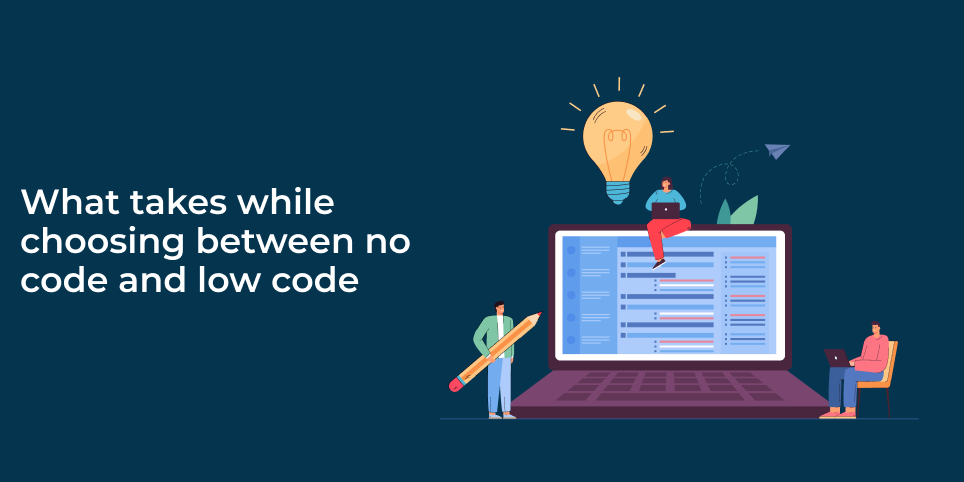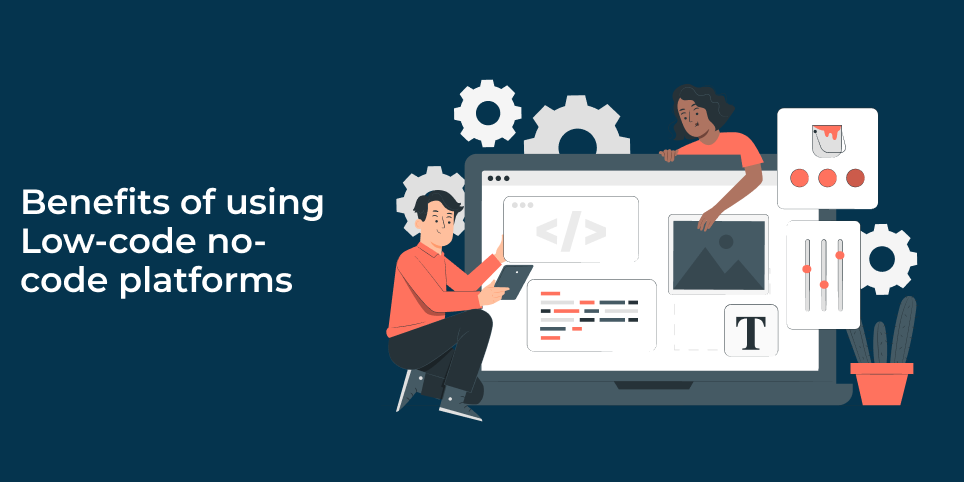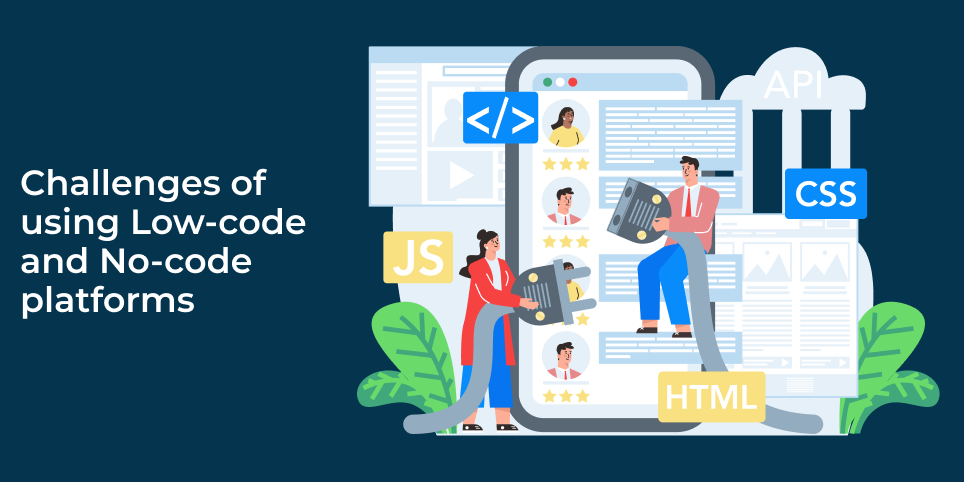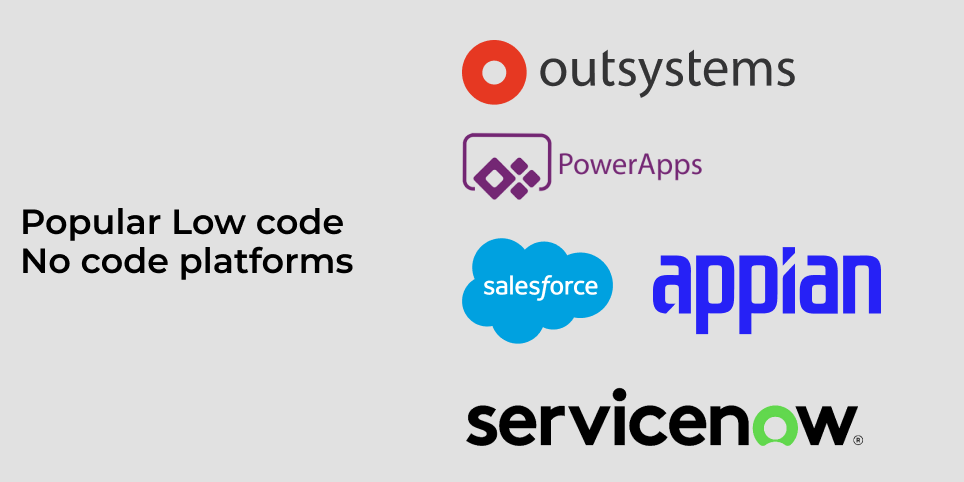
Low-Code No-Code – A Short Guide To Help You Decide Which is Suitable
Table of Contents
- What is Low-code No-code?
- What is No-code?
- What is Low-code?
- Difference between Low-code and No-code
- How does the No-code Low-code work?
- What takes while choosing between no code and low code
- Benefits of using Low-code no-code platforms
- Challenges of using Low-code and No-code platforms
- Popular Low code No code platforms
- Is Low-code No-code the Forthcoming Trend of App Development
If you are unfamiliar with the terms low-code and no-code, then you are at the right place. Here we will learn about low-code and no-code and how to choose from the two. Those new to the world of code might end up mixing low-code and no-code initially. There are a lot of large companies which still face a lot of difficulty in differentiating between low-code and no-code. Both the low-code and no-code are minimal code platforms, and each has its own set of advantages and disadvantages. Both are unique and are used in different case scenarios.
What is Low-code No-code?
Developers and designers are increasingly using low-code platforms. There are numerous reasons for this. Among the problems include market competitiveness, a shortage of seasoned engineers, schedule restraints, and overworked IT personnel. Let’s examine the definitions of the two terminologies.
What is No-code?
No-code system does not require any kind of code. If you are making apps with it, you will not require any prior knowledge about coding languages. Developers will be able to design and make apps without any kind of experience. No-code applications might be compared to well-liked blogging and e-commerce website-building tools like WordPress and Shopify. You may make apps with visuals and drag-and-drop tools, thanks to them. The pre-built pages can be used to launch your blog or company. This software represents the self-service movement. Business users can thus create data-driven apps and accomplish their objectives.
What is Low-code?
There are platforms with low code which are quite popular compared to conventional platforms. These platforms require a bit of coding but not as much as conventional platforms. They are not, however, constrained by repetitive code or redundant tasks. So, to create an app, you must have at least fundamental coding knowledge. The shortcuts are the key advantage that consumers can take advantage of. Skilled users can use these shortcuts to work more efficiently and quickly. In a low-code platform, they can just employ visuals with simple drop-down features. These straightforward techniques can be used to create apps by non-coders as well. For instance, they can create commercial and mobile apps.
Difference between Low-code and No-code
With the help of low-code and no-code applications, a broader audience gets opened up who can code and create applications independently. Low-code and No-code might look similar, but they are quite different in real life. In Low-code, users are free to move between platforms, but with no code, they will be stuck with one platform. Low code allows users to create complex applications, whereas No-code allows users to create simple apps. Low code is the next professional tool to help professionals build apps, whereas No code strictly targets business users. People who have an existing IT team should go for Low-code.
How does the No-code Low-code work?
The Low code no code solution is designed specifically for users that are looking to launch programs fast. The reason behind the creation of low code no code is to ensure that developers move away from programming. This helps shift visual components of codes already written to address different business issues. Reusing codes surely helps save a lot of time, money, and manpower. Utilizing low-code, no-code platforms, users’ productivity typically increases. Instead of spending hours in coding, they concentrate on more significant business issues.
What takes while choosing between no code and low code

Most of the time, designers prefer using no code as they have a limited amount of knowledge about the different coding languages. Most developers like to use low code as it is quite flexible, and by reusing code, an app can be developed in a very short time. No-code platforms are too simple to handle use situations with many variables. Low-code systems, however, are challenging for non-technical users. This is where choosing a course of action becomes challenging. Low code will help developers code quickie without compromising accuracy because all the pre-existing codes are already tested.
There are a few factors to consider while deciding between Low code and No code. Make sure to consider the following factors before making a decision.
Return On Investment
When it comes to ROI, you will have to keep in mind Speed to Value. Both methods use a modular approach which will help you complete different tasks quickly. Businesses can add value by enhancing compliance or the user experience. New items or services can also be delivered more quickly. Additionally, you can accelerate your goal of digital transformation.
Costs
The main reason behind using low code no code is the cost. Businesses can save a lot of money on a huge team of developers and spend it in a different way to grow business with the help of a low-code no-code approach.
Right Infrastructural Fit
With the help of low-code no-code methods, infrastructure is not required. Businesses may benefit from the newest technologies, including artificial intelligence and machine learning.
Safety and Security
The low-code no-code methods are quite secure and have been tested multiple times. Make sure to have a standby IT team assigned to keep the apps designed by no code low-code safe. Deploying user-built apps within a framework is necessary.
Benefits of using Low-code no-code platforms

Platforms with low or no code make it simple for tech enthusiasts to develop and distribute programs. They don’t have to be concerned about scalability or operating systems. If you need a rapid fix for a specific business issue, low-code no-code is suitable.
The advantages of low-code no-code platforms are listed below.
Improved Customer Experience
The user experience of Low code No code is unique and easy, and creating apps with it is undoubtedly convenient for everyone. People that use low-code and no-code can give their clients a fantastic user interface.
Fast Deliveries
Low-code, no-code streamlines the process and gets rid of difficult problems. This helps users to design and distribute different applications rapidly. In addition, combining third-party tools is also viable with low-code no-code platforms. The learning curve is minimized or eliminated because the teams are already accustomed to them.
Flexible Solutions
Low code no code is known to be quite flexible as users will be able to code in multiple languages and combine them to create one application. Apps are getting quite advanced, so it is important to make them flexible for a better user experience.
Cost Reduction
Not only does the low code no code help save time but also a lot of money during its development stages. Very less amount of training is required for low code no code, which eventually saves a lot of money for a company.
High Efficiency
Low-code, no-code software enables users to increase productivity. They can accelerate app development and delivery. A low-code no-code platform also allows users to complete the project rapidly. They don’t have to work with an app development team for months.
Challenges of using Low-code and No-code platforms

After the introduction of Low-code No-code platforms, users are no longer obligated to go through lengthy development cycles. The platform might not be able to cater to all the needs of the user but most of them will be fulfilled. Make sure to keep in mind the below-given points before choosing this platform.
Limited Freedom
There is no movement of code from one low-code no-code platform to another. Make sure to get a good understanding of all the policies before you start using this platform. Make sure the app can sustain itself without the help of a low-code no-code platform.
Security Concerns
Using low-code no-code platforms might not always be secure because of their limitations. Additional security measures need to be added to the program. The security depends on the platform to platform. Check the security of any app developed on the Low-code no-code platform.
Low customization options
Platforms offer different options for customization. While some low-code no-code systems restrict editing options, others allow access to the source code. Similarly, some will let you create custom apps while others won’t. Therefore, before working with any platform, understand your restrictions carefully.
Rigid Template
Low-code no-code platforms have a fixed number of templates available from which users must choose. Each component is unique but has been used multiple times. The template will sometimes feel rigid because of the lack of building blocks. Uniqueness in the created apps will always be missing when you use Low-code, No-code platforms.
Limited Integration Options
Platforms with no coding emphasized productivity. They cannot link to older systems while concentrating on a single user experience. It limits the ways that users can integrate. Additionally, the supplier forbids third-party or internal system custom integrations.
Governance
The development of apps on these low-code platforms may provide certain governance problems. Because no-code apps are standalone, it could be challenging. Additionally, uncontrolled data formats and quality levels might proliferate widely.
Popular Low code No code platforms

The popularity of low code No code platforms has been growing quite rapidly, which is why they are getting so much attention. Here are listed some of the best Low code No code platforms available in the market.
Salesforce
The development of apps on the platform is well-established. It aims to serve non-technical business users. Furthermore, its low-code solutions are the same. The entire toolkit for building business apps is available on the Salesforce Platform.
OutSystems
OutSystems is a top-notch low-code tool that meets the expanding need for continuous delivery. Its solutions use AI to assist users in creating apps in a visual setting. Additionally, it grants usage permissions based on responsibilities. Enabling people to develop at their rate. In OutSystems, its platform services automate the app-building lifecycle. The platform also makes use of original apps and templates. A library of UX elements, drop-down UI, business procedures, logic, and data models are available for use.
Microsoft Power Apps
The platform aids in the creation of robust online and mobile applications. It is based on the Common Data Service from Microsoft. You can make numerous apps simultaneously here. The platform solution is also linked to significant data. The business data is kept in the underlying data platform or other online data sources. PowerApps Studio is the best tool for developing canvas apps.
Appian
All kinds of enterprises can use the low-code platform called Appian. It is a solitary platform that is dedicated to automating intricate procedures. Users can utilize it to create BPM apps. Using Appian’s social collaboration platform, users can communicate with other team members to discuss projects. Additionally, the platform offers pre-built connectors for integrating with other programs. You don’t need to write any code for this.
Document management also has access to data and analytics.
ServiceNow
The pioneer of low-code platforms is ServiceNow. Anyone can use the platform to design, enhance, and automate digital workflows. Users of all skill levels are welcome to use its programs and frameworks. Users can also create apps using its Now Platform. The platform offers a fantastic app architecture. Thus, it makes it simpler to create apps for various corporate tasks.
Is Low-code No-code the Forthcoming Trend of App Development
The answer to this question is Yes. It is expected that the Low code No code platform will grow by almost 40 percent in the coming years. Solutions with little or no coding are becoming important for accelerating app release. Every day, we observe the release of new platform features, upgrades, and solutions. They do bridge the gap between the abilities of a non-coder and those of a coder. Solutions with little or no coding are becoming important for accelerating app release. Every day, we observe the release of new platform features, upgrades, and solutions. They do bridge the gap between the abilities of a non-coder and those of a full-fledged coder.
If we are focusing on the practical and cost-effective app, then there is no better option than using Low code No code. This platform will successfully establish its place in the development stage. All the applications created by the platform are quite easy to use and have a good user interface. If you do not have much knowledge about coding, then using this platform will surely make your life easy.



